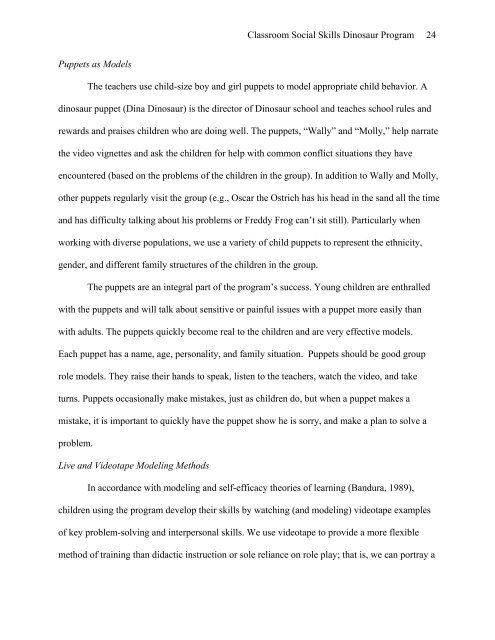Classroom Social Skills Dinosaur Program 1 Running head ...
Classroom Social Skills Dinosaur Program 1 Running head ...
Classroom Social Skills Dinosaur Program 1 Running head ...
Create successful ePaper yourself
Turn your PDF publications into a flip-book with our unique Google optimized e-Paper software.
<strong>Classroom</strong> <strong>Social</strong> <strong>Skills</strong> <strong>Dinosaur</strong> <strong>Program</strong> 24<br />
Puppets as Models<br />
The teachers use child-size boy and girl puppets to model appropriate child behavior. A<br />
dinosaur puppet (Dina <strong>Dinosaur</strong>) is the director of <strong>Dinosaur</strong> school and teaches school rules and<br />
rewards and praises children who are doing well. The puppets, “Wally” and “Molly,” help narrate<br />
the video vignettes and ask the children for help with common conflict situations they have<br />
encountered (based on the problems of the children in the group). In addition to Wally and Molly,<br />
other puppets regularly visit the group (e.g., Oscar the Ostrich has his <strong>head</strong> in the sand all the time<br />
and has difficulty talking about his problems or Freddy Frog can’t sit still). Particularly when<br />
working with diverse populations, we use a variety of child puppets to represent the ethnicity,<br />
gender, and different family structures of the children in the group.<br />
The puppets are an integral part of the program’s success. Young children are enthralled<br />
with the puppets and will talk about sensitive or painful issues with a puppet more easily than<br />
with adults. The puppets quickly become real to the children and are very effective models.<br />
Each puppet has a name, age, personality, and family situation. Puppets should be good group<br />
role models. They raise their hands to speak, listen to the teachers, watch the video, and take<br />
turns. Puppets occasionally make mistakes, just as children do, but when a puppet makes a<br />
mistake, it is important to quickly have the puppet show he is sorry, and make a plan to solve a<br />
problem.<br />
Live and Videotape Modeling Methods<br />
In accordance with modeling and self-efficacy theories of learning (Bandura, 1989),<br />
children using the program develop their skills by watching (and modeling) videotape examples<br />
of key problem-solving and interpersonal skills. We use videotape to provide a more flexible<br />
method of training than didactic instruction or sole reliance on role play; that is, we can portray a
















